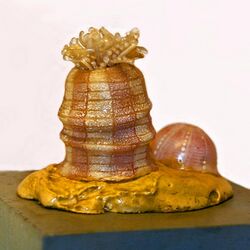Biology:Aulactinia verrucosa
| Aulactinia verrucosa | |
|---|---|

| |
| Glass model of Aulactinia verrucosa | |
| Scientific classification | |
| Domain: | Eukaryota |
| Kingdom: | Animalia |
| Phylum: | Cnidaria |
| Class: | Hexacorallia |
| Order: | Actiniaria |
| Family: | Actiniidae |
| Genus: | Aulactinia |
| Species: | A. verrucosa
|
| Binomial name | |
| Aulactinia verrucosa (Pennant, 1777)[1]
| |
| Synonyms[1] | |
|
List
| |
Aulactinia verrucosa, the gem anemone, is a species of sea anemone in the family Actiniidae. It is found on rocky coasts in the northeastern Atlantic Ocean, North Sea and Mediterranean Sea.
Description
Aulactinia verrucosa has a cylindrical body and is wider at the base than at the crown. The base is up to 25 mm (1 in) wide and the column 50 mm (2 in) tall. The walls of the column are covered by wart-like tubercles known as verrucae. Above the column, there are up to forty-eight tentacles, arranged in six cycles. The column is pink or grey, the tubercles grey or white, and the tentacles transparent and banded in pink, grey or olive.[3]
Distribution and habitat
Aulactinia verrucosa is native to the northeastern Atlantic Ocean, the North Sea and the Mediterranean Sea.[1] Its northern limit is Shetland and western Scotland and it is present all round the coasts of Ireland. It is found on rocky shores both in areas with strong currents and in calmer waters. It is present in crevices and in rock pools, often among calcified red algae (Corallina), and also attached to the rock beneath the sediment in rock pools.[3]
References
- ↑ 1.0 1.1 1.2 van der Land, Jacob (2014). "Aulactinia verrucosa (Pennant, 1777)". WoRMS. World Register of Marine Species. http://www.marinespecies.org/aphia.php?p=taxdetails&id=100815.
- ↑ OSCAR OCAÑA & J.C. DEN HARTOG A CATALOGUE OF ACTINIARIA AND CORALLIMORPHARIA FROM THECANARY ISLANDS AND FROM MADEIRA
- ↑ 3.0 3.1 "Gem anemone - Aulactinia verrucosa - General information". Marine Life Information Network. http://www.marlin.ac.uk/speciesfullreview.php?speciesID=2682#. Retrieved 2014-12-12.
External links
- Photos of Aulactinia verrucosa on Sealife Collection
Wikidata ☰ Q2017782 entry
 |


